MKT01760 - New Tourism Plan: Addressing Emerging Issues in Australia
VerifiedAdded on 2023/06/07
|12
|4164
|456
Report
AI Summary
This report presents a proposed tourism plan for Australia, focusing on addressing emerging issues within the tourism sector. It begins with a position statement outlining the roles and responsibilities of the United Travel Corporation, a Melbourne-based tour operator, and the internal and external influences affecting its operations. The report highlights the need for a new tourism plan to leverage technologies for readiness and optimization, adapting to changes in the target market and identifying opportunities and challenges. The background context details the growth of the Australian tourism industry, its economic contribution, and existing challenges such as the lack of online presence for operators and skills shortages. The report emphasizes the importance of technology in tourism development, addressing issues like political stability, competition, and consumer perception. The statement of need underscores the necessity of the plan to enhance tourism through updated technologies, address skills and infrastructure gaps, and align with government policies and stakeholder involvement. Key trends influencing the plan include augmented and virtual reality, artificial intelligence, the internet of things, voice technology, and Wi-Fi connectivity. The report concludes by highlighting the challenge for the United Travel Corporation to keep up with rapid technological advancements and the need to utilize technology to reach its client base effectively.
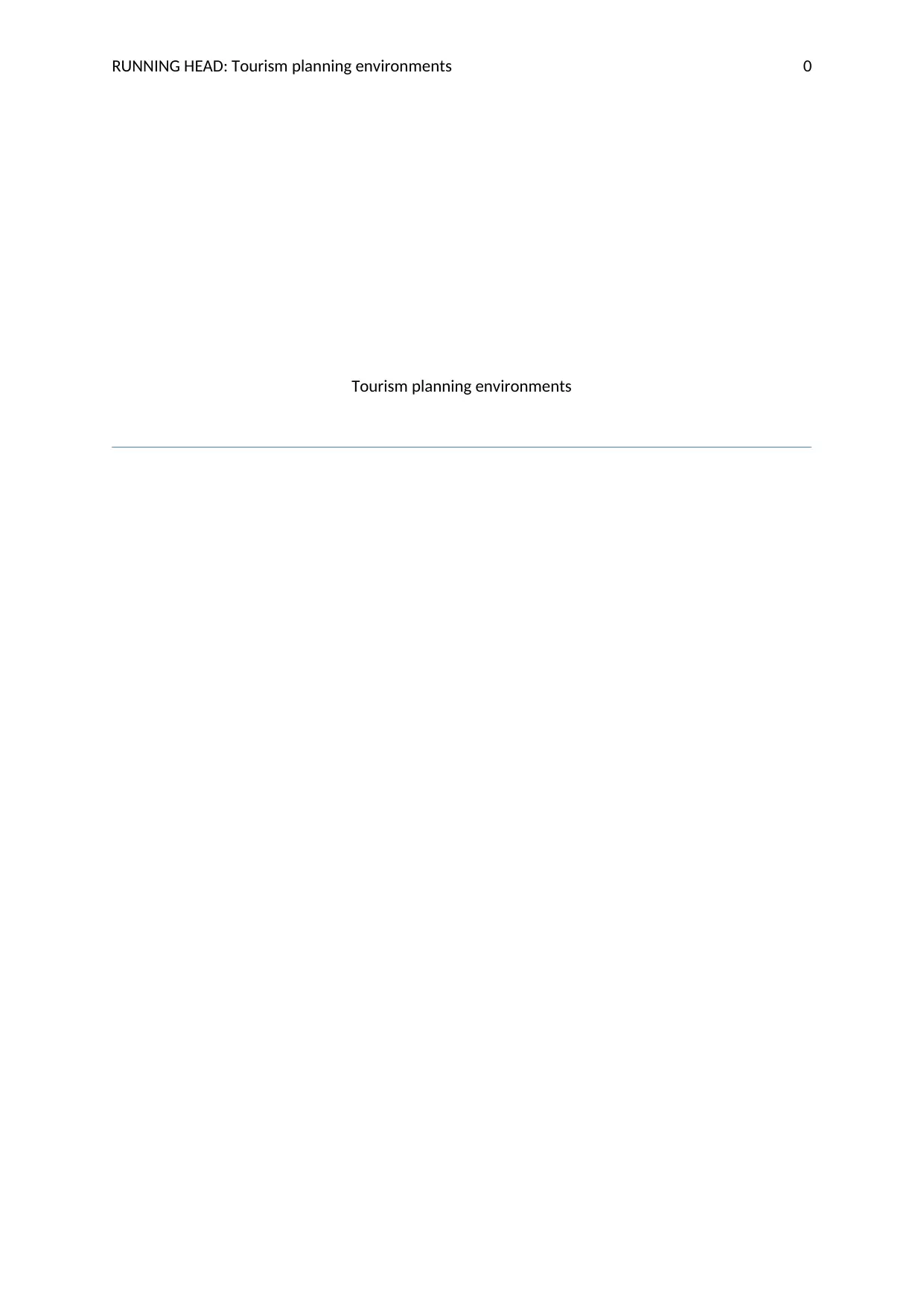
RUNNING HEAD: Tourism planning environments 0
Tourism planning environments
Tourism planning environments
Paraphrase This Document
Need a fresh take? Get an instant paraphrase of this document with our AI Paraphraser
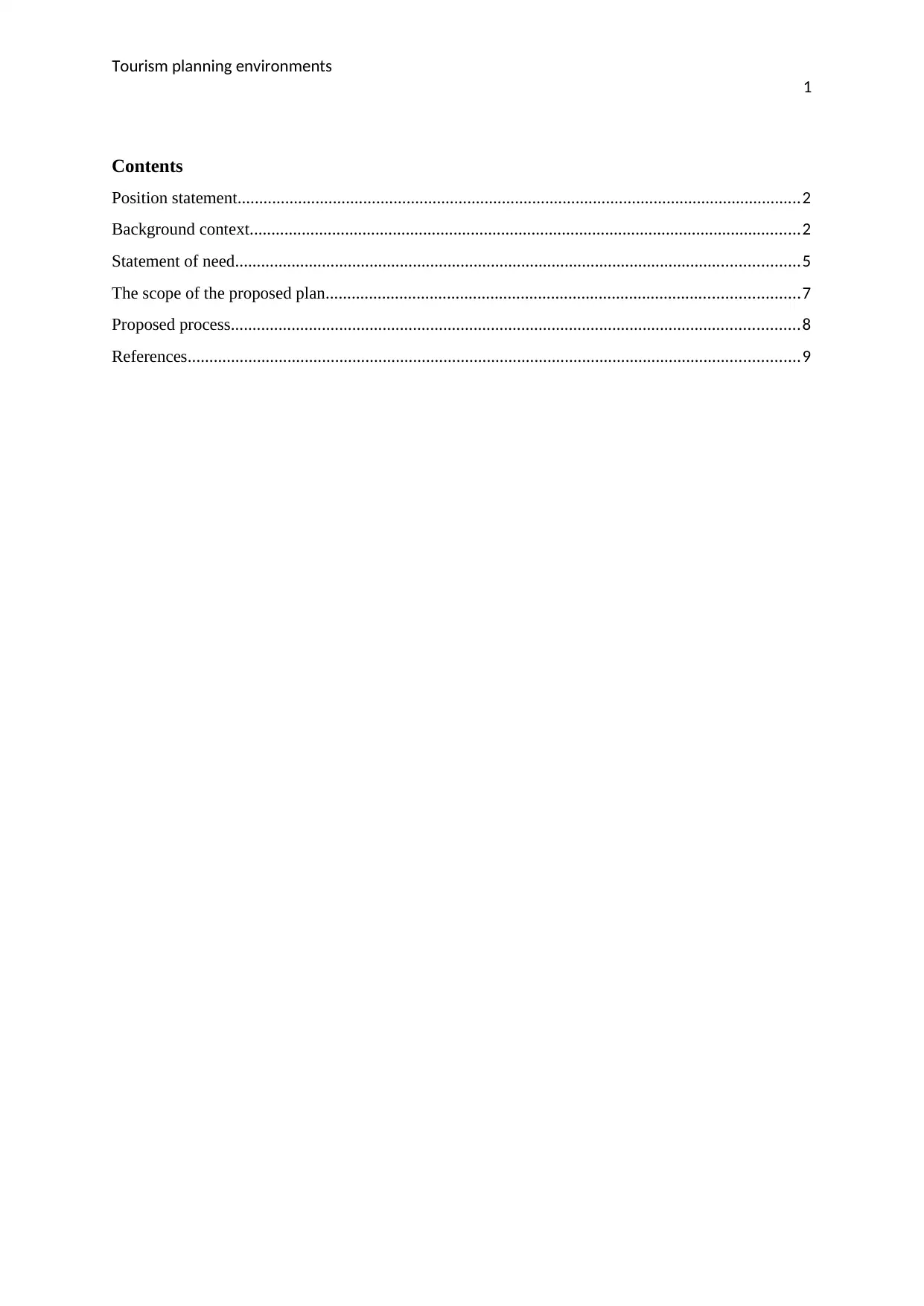
Tourism planning environments
1
Contents
Position statement..................................................................................................................................2
Background context...............................................................................................................................2
Statement of need..................................................................................................................................5
The scope of the proposed plan.............................................................................................................7
Proposed process...................................................................................................................................8
References.............................................................................................................................................9
1
Contents
Position statement..................................................................................................................................2
Background context...............................................................................................................................2
Statement of need..................................................................................................................................5
The scope of the proposed plan.............................................................................................................7
Proposed process...................................................................................................................................8
References.............................................................................................................................................9
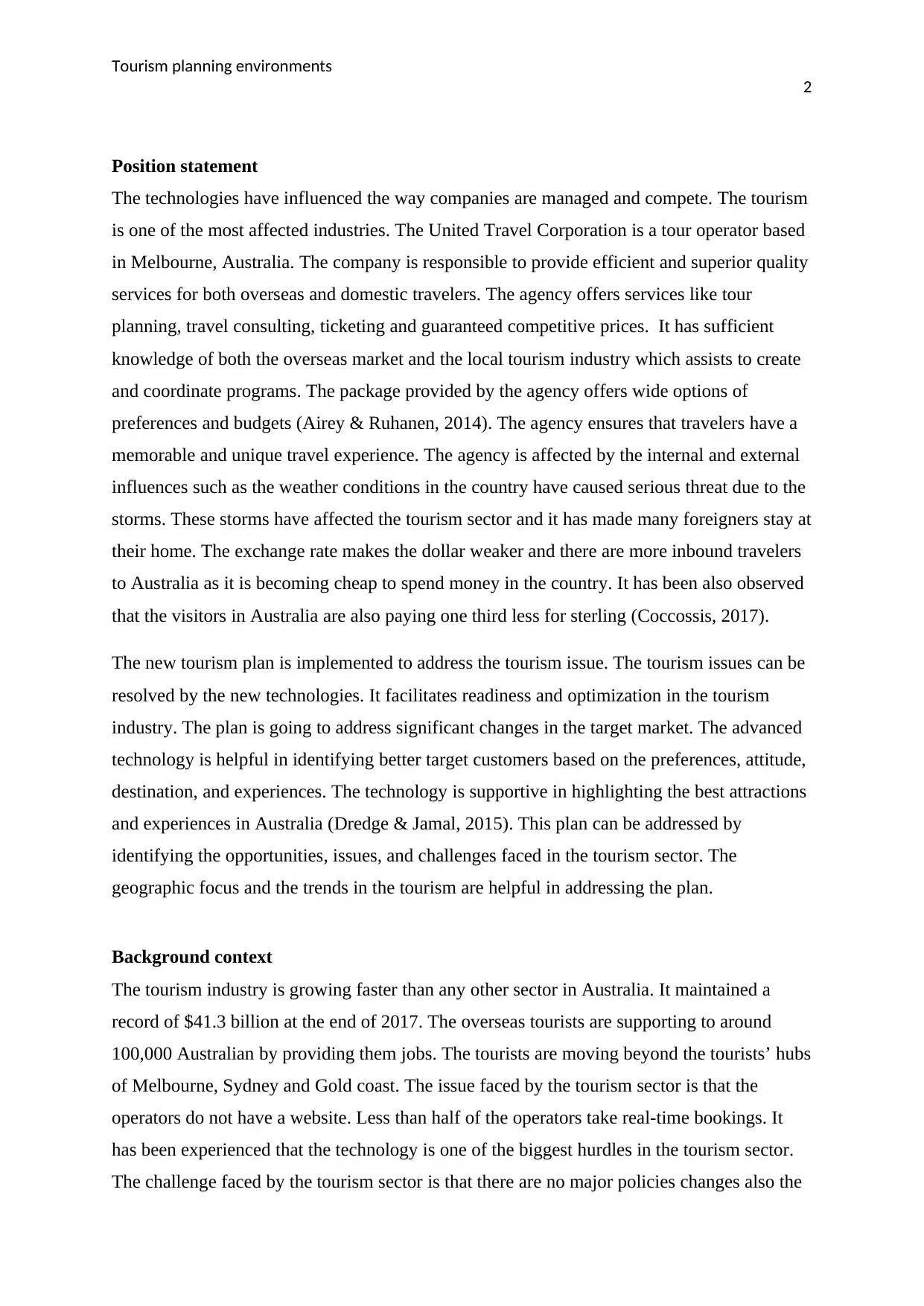
Tourism planning environments
2
Position statement
The technologies have influenced the way companies are managed and compete. The tourism
is one of the most affected industries. The United Travel Corporation is a tour operator based
in Melbourne, Australia. The company is responsible to provide efficient and superior quality
services for both overseas and domestic travelers. The agency offers services like tour
planning, travel consulting, ticketing and guaranteed competitive prices. It has sufficient
knowledge of both the overseas market and the local tourism industry which assists to create
and coordinate programs. The package provided by the agency offers wide options of
preferences and budgets (Airey & Ruhanen, 2014). The agency ensures that travelers have a
memorable and unique travel experience. The agency is affected by the internal and external
influences such as the weather conditions in the country have caused serious threat due to the
storms. These storms have affected the tourism sector and it has made many foreigners stay at
their home. The exchange rate makes the dollar weaker and there are more inbound travelers
to Australia as it is becoming cheap to spend money in the country. It has been also observed
that the visitors in Australia are also paying one third less for sterling (Coccossis, 2017).
The new tourism plan is implemented to address the tourism issue. The tourism issues can be
resolved by the new technologies. It facilitates readiness and optimization in the tourism
industry. The plan is going to address significant changes in the target market. The advanced
technology is helpful in identifying better target customers based on the preferences, attitude,
destination, and experiences. The technology is supportive in highlighting the best attractions
and experiences in Australia (Dredge & Jamal, 2015). This plan can be addressed by
identifying the opportunities, issues, and challenges faced in the tourism sector. The
geographic focus and the trends in the tourism are helpful in addressing the plan.
Background context
The tourism industry is growing faster than any other sector in Australia. It maintained a
record of $41.3 billion at the end of 2017. The overseas tourists are supporting to around
100,000 Australian by providing them jobs. The tourists are moving beyond the tourists’ hubs
of Melbourne, Sydney and Gold coast. The issue faced by the tourism sector is that the
operators do not have a website. Less than half of the operators take real-time bookings. It
has been experienced that the technology is one of the biggest hurdles in the tourism sector.
The challenge faced by the tourism sector is that there are no major policies changes also the
2
Position statement
The technologies have influenced the way companies are managed and compete. The tourism
is one of the most affected industries. The United Travel Corporation is a tour operator based
in Melbourne, Australia. The company is responsible to provide efficient and superior quality
services for both overseas and domestic travelers. The agency offers services like tour
planning, travel consulting, ticketing and guaranteed competitive prices. It has sufficient
knowledge of both the overseas market and the local tourism industry which assists to create
and coordinate programs. The package provided by the agency offers wide options of
preferences and budgets (Airey & Ruhanen, 2014). The agency ensures that travelers have a
memorable and unique travel experience. The agency is affected by the internal and external
influences such as the weather conditions in the country have caused serious threat due to the
storms. These storms have affected the tourism sector and it has made many foreigners stay at
their home. The exchange rate makes the dollar weaker and there are more inbound travelers
to Australia as it is becoming cheap to spend money in the country. It has been also observed
that the visitors in Australia are also paying one third less for sterling (Coccossis, 2017).
The new tourism plan is implemented to address the tourism issue. The tourism issues can be
resolved by the new technologies. It facilitates readiness and optimization in the tourism
industry. The plan is going to address significant changes in the target market. The advanced
technology is helpful in identifying better target customers based on the preferences, attitude,
destination, and experiences. The technology is supportive in highlighting the best attractions
and experiences in Australia (Dredge & Jamal, 2015). This plan can be addressed by
identifying the opportunities, issues, and challenges faced in the tourism sector. The
geographic focus and the trends in the tourism are helpful in addressing the plan.
Background context
The tourism industry is growing faster than any other sector in Australia. It maintained a
record of $41.3 billion at the end of 2017. The overseas tourists are supporting to around
100,000 Australian by providing them jobs. The tourists are moving beyond the tourists’ hubs
of Melbourne, Sydney and Gold coast. The issue faced by the tourism sector is that the
operators do not have a website. Less than half of the operators take real-time bookings. It
has been experienced that the technology is one of the biggest hurdles in the tourism sector.
The challenge faced by the tourism sector is that there are no major policies changes also the
⊘ This is a preview!⊘
Do you want full access?
Subscribe today to unlock all pages.

Trusted by 1+ million students worldwide
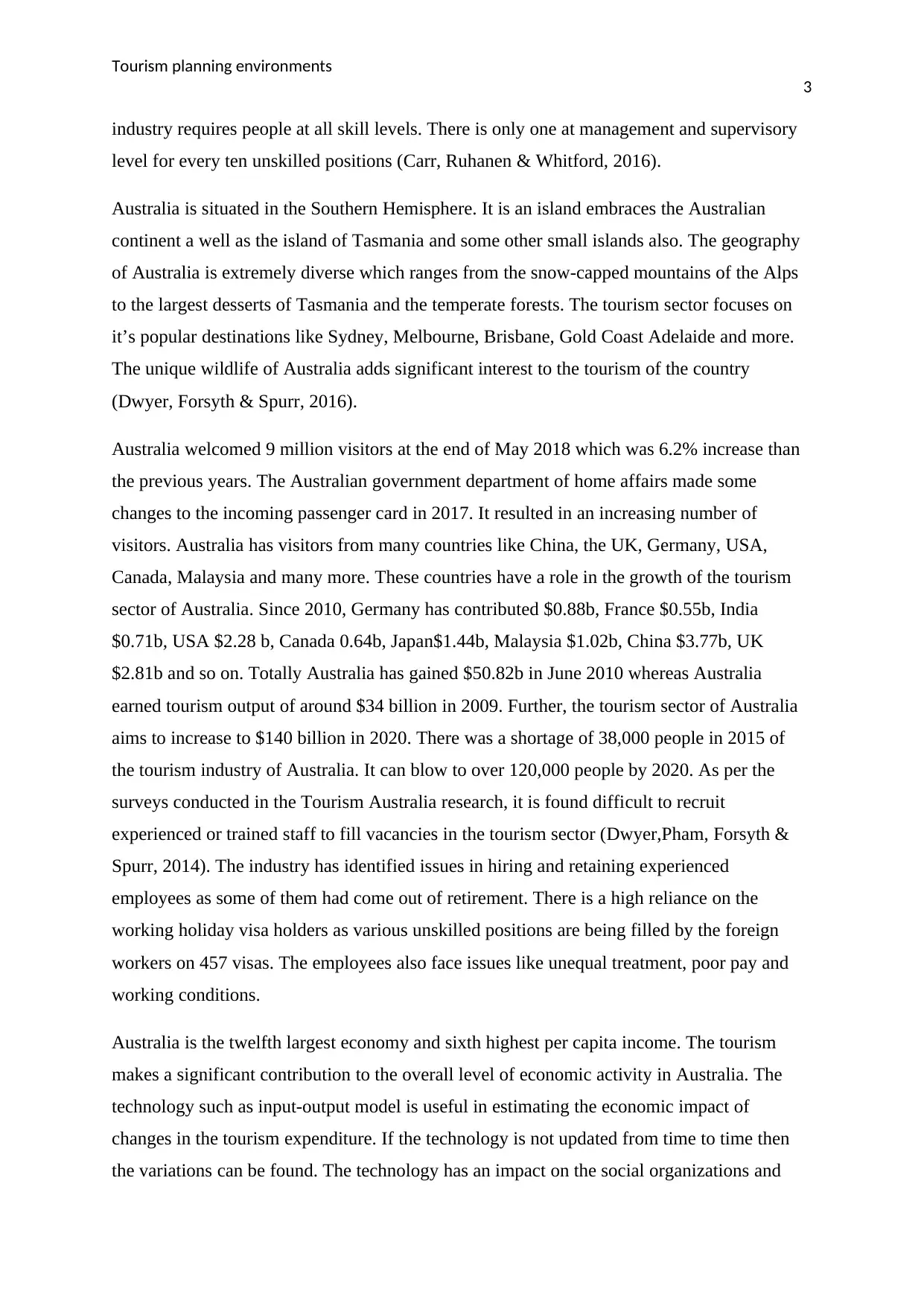
Tourism planning environments
3
industry requires people at all skill levels. There is only one at management and supervisory
level for every ten unskilled positions (Carr, Ruhanen & Whitford, 2016).
Australia is situated in the Southern Hemisphere. It is an island embraces the Australian
continent a well as the island of Tasmania and some other small islands also. The geography
of Australia is extremely diverse which ranges from the snow-capped mountains of the Alps
to the largest desserts of Tasmania and the temperate forests. The tourism sector focuses on
it’s popular destinations like Sydney, Melbourne, Brisbane, Gold Coast Adelaide and more.
The unique wildlife of Australia adds significant interest to the tourism of the country
(Dwyer, Forsyth & Spurr, 2016).
Australia welcomed 9 million visitors at the end of May 2018 which was 6.2% increase than
the previous years. The Australian government department of home affairs made some
changes to the incoming passenger card in 2017. It resulted in an increasing number of
visitors. Australia has visitors from many countries like China, the UK, Germany, USA,
Canada, Malaysia and many more. These countries have a role in the growth of the tourism
sector of Australia. Since 2010, Germany has contributed $0.88b, France $0.55b, India
$0.71b, USA $2.28 b, Canada 0.64b, Japan$1.44b, Malaysia $1.02b, China $3.77b, UK
$2.81b and so on. Totally Australia has gained $50.82b in June 2010 whereas Australia
earned tourism output of around $34 billion in 2009. Further, the tourism sector of Australia
aims to increase to $140 billion in 2020. There was a shortage of 38,000 people in 2015 of
the tourism industry of Australia. It can blow to over 120,000 people by 2020. As per the
surveys conducted in the Tourism Australia research, it is found difficult to recruit
experienced or trained staff to fill vacancies in the tourism sector (Dwyer,Pham, Forsyth &
Spurr, 2014). The industry has identified issues in hiring and retaining experienced
employees as some of them had come out of retirement. There is a high reliance on the
working holiday visa holders as various unskilled positions are being filled by the foreign
workers on 457 visas. The employees also face issues like unequal treatment, poor pay and
working conditions.
Australia is the twelfth largest economy and sixth highest per capita income. The tourism
makes a significant contribution to the overall level of economic activity in Australia. The
technology such as input-output model is useful in estimating the economic impact of
changes in the tourism expenditure. If the technology is not updated from time to time then
the variations can be found. The technology has an impact on the social organizations and
3
industry requires people at all skill levels. There is only one at management and supervisory
level for every ten unskilled positions (Carr, Ruhanen & Whitford, 2016).
Australia is situated in the Southern Hemisphere. It is an island embraces the Australian
continent a well as the island of Tasmania and some other small islands also. The geography
of Australia is extremely diverse which ranges from the snow-capped mountains of the Alps
to the largest desserts of Tasmania and the temperate forests. The tourism sector focuses on
it’s popular destinations like Sydney, Melbourne, Brisbane, Gold Coast Adelaide and more.
The unique wildlife of Australia adds significant interest to the tourism of the country
(Dwyer, Forsyth & Spurr, 2016).
Australia welcomed 9 million visitors at the end of May 2018 which was 6.2% increase than
the previous years. The Australian government department of home affairs made some
changes to the incoming passenger card in 2017. It resulted in an increasing number of
visitors. Australia has visitors from many countries like China, the UK, Germany, USA,
Canada, Malaysia and many more. These countries have a role in the growth of the tourism
sector of Australia. Since 2010, Germany has contributed $0.88b, France $0.55b, India
$0.71b, USA $2.28 b, Canada 0.64b, Japan$1.44b, Malaysia $1.02b, China $3.77b, UK
$2.81b and so on. Totally Australia has gained $50.82b in June 2010 whereas Australia
earned tourism output of around $34 billion in 2009. Further, the tourism sector of Australia
aims to increase to $140 billion in 2020. There was a shortage of 38,000 people in 2015 of
the tourism industry of Australia. It can blow to over 120,000 people by 2020. As per the
surveys conducted in the Tourism Australia research, it is found difficult to recruit
experienced or trained staff to fill vacancies in the tourism sector (Dwyer,Pham, Forsyth &
Spurr, 2014). The industry has identified issues in hiring and retaining experienced
employees as some of them had come out of retirement. There is a high reliance on the
working holiday visa holders as various unskilled positions are being filled by the foreign
workers on 457 visas. The employees also face issues like unequal treatment, poor pay and
working conditions.
Australia is the twelfth largest economy and sixth highest per capita income. The tourism
makes a significant contribution to the overall level of economic activity in Australia. The
technology such as input-output model is useful in estimating the economic impact of
changes in the tourism expenditure. If the technology is not updated from time to time then
the variations can be found. The technology has an impact on the social organizations and
Paraphrase This Document
Need a fresh take? Get an instant paraphrase of this document with our AI Paraphraser
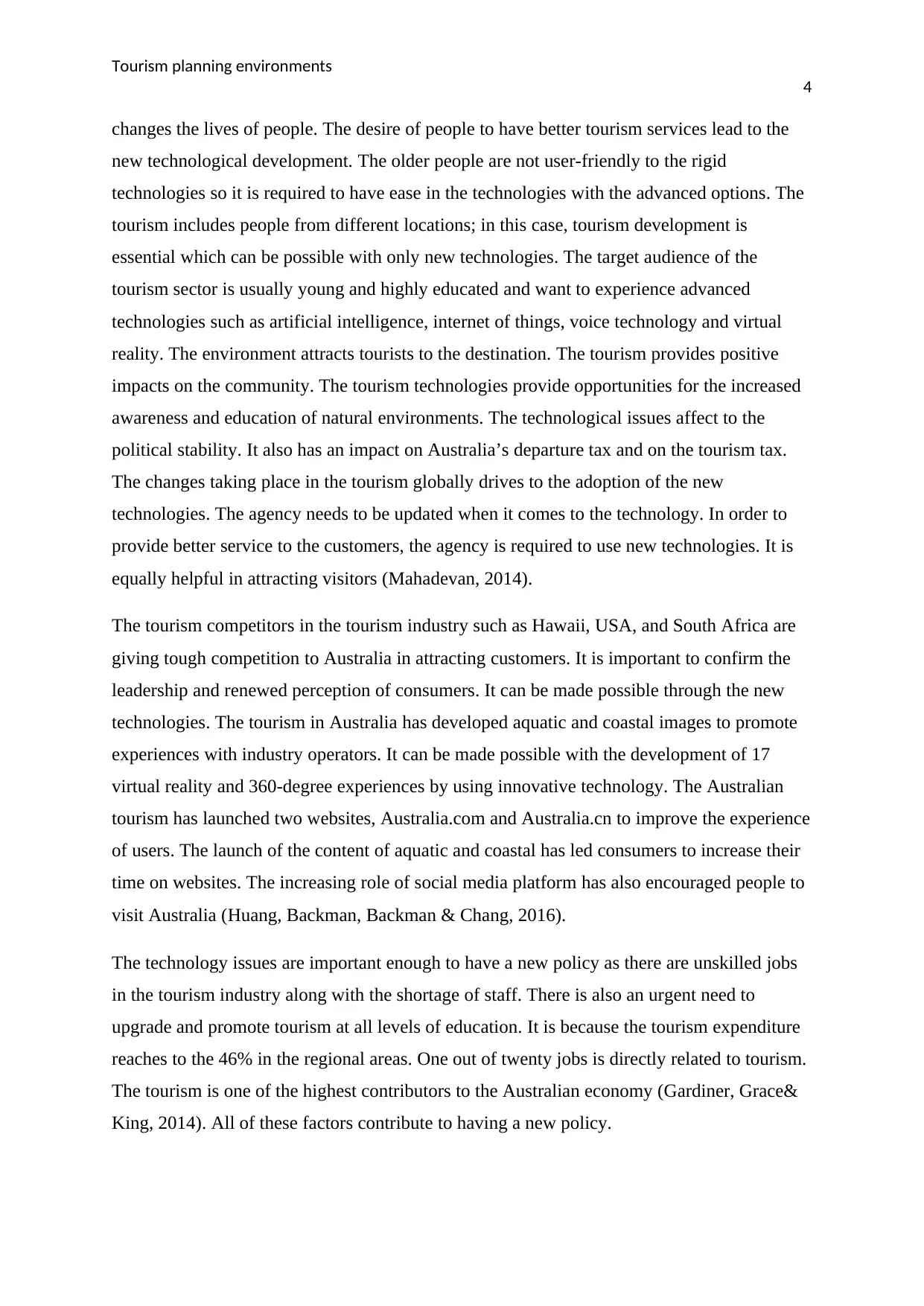
Tourism planning environments
4
changes the lives of people. The desire of people to have better tourism services lead to the
new technological development. The older people are not user-friendly to the rigid
technologies so it is required to have ease in the technologies with the advanced options. The
tourism includes people from different locations; in this case, tourism development is
essential which can be possible with only new technologies. The target audience of the
tourism sector is usually young and highly educated and want to experience advanced
technologies such as artificial intelligence, internet of things, voice technology and virtual
reality. The environment attracts tourists to the destination. The tourism provides positive
impacts on the community. The tourism technologies provide opportunities for the increased
awareness and education of natural environments. The technological issues affect to the
political stability. It also has an impact on Australia’s departure tax and on the tourism tax.
The changes taking place in the tourism globally drives to the adoption of the new
technologies. The agency needs to be updated when it comes to the technology. In order to
provide better service to the customers, the agency is required to use new technologies. It is
equally helpful in attracting visitors (Mahadevan, 2014).
The tourism competitors in the tourism industry such as Hawaii, USA, and South Africa are
giving tough competition to Australia in attracting customers. It is important to confirm the
leadership and renewed perception of consumers. It can be made possible through the new
technologies. The tourism in Australia has developed aquatic and coastal images to promote
experiences with industry operators. It can be made possible with the development of 17
virtual reality and 360-degree experiences by using innovative technology. The Australian
tourism has launched two websites, Australia.com and Australia.cn to improve the experience
of users. The launch of the content of aquatic and coastal has led consumers to increase their
time on websites. The increasing role of social media platform has also encouraged people to
visit Australia (Huang, Backman, Backman & Chang, 2016).
The technology issues are important enough to have a new policy as there are unskilled jobs
in the tourism industry along with the shortage of staff. There is also an urgent need to
upgrade and promote tourism at all levels of education. It is because the tourism expenditure
reaches to the 46% in the regional areas. One out of twenty jobs is directly related to tourism.
The tourism is one of the highest contributors to the Australian economy (Gardiner, Grace&
King, 2014). All of these factors contribute to having a new policy.
4
changes the lives of people. The desire of people to have better tourism services lead to the
new technological development. The older people are not user-friendly to the rigid
technologies so it is required to have ease in the technologies with the advanced options. The
tourism includes people from different locations; in this case, tourism development is
essential which can be possible with only new technologies. The target audience of the
tourism sector is usually young and highly educated and want to experience advanced
technologies such as artificial intelligence, internet of things, voice technology and virtual
reality. The environment attracts tourists to the destination. The tourism provides positive
impacts on the community. The tourism technologies provide opportunities for the increased
awareness and education of natural environments. The technological issues affect to the
political stability. It also has an impact on Australia’s departure tax and on the tourism tax.
The changes taking place in the tourism globally drives to the adoption of the new
technologies. The agency needs to be updated when it comes to the technology. In order to
provide better service to the customers, the agency is required to use new technologies. It is
equally helpful in attracting visitors (Mahadevan, 2014).
The tourism competitors in the tourism industry such as Hawaii, USA, and South Africa are
giving tough competition to Australia in attracting customers. It is important to confirm the
leadership and renewed perception of consumers. It can be made possible through the new
technologies. The tourism in Australia has developed aquatic and coastal images to promote
experiences with industry operators. It can be made possible with the development of 17
virtual reality and 360-degree experiences by using innovative technology. The Australian
tourism has launched two websites, Australia.com and Australia.cn to improve the experience
of users. The launch of the content of aquatic and coastal has led consumers to increase their
time on websites. The increasing role of social media platform has also encouraged people to
visit Australia (Huang, Backman, Backman & Chang, 2016).
The technology issues are important enough to have a new policy as there are unskilled jobs
in the tourism industry along with the shortage of staff. There is also an urgent need to
upgrade and promote tourism at all levels of education. It is because the tourism expenditure
reaches to the 46% in the regional areas. One out of twenty jobs is directly related to tourism.
The tourism is one of the highest contributors to the Australian economy (Gardiner, Grace&
King, 2014). All of these factors contribute to having a new policy.
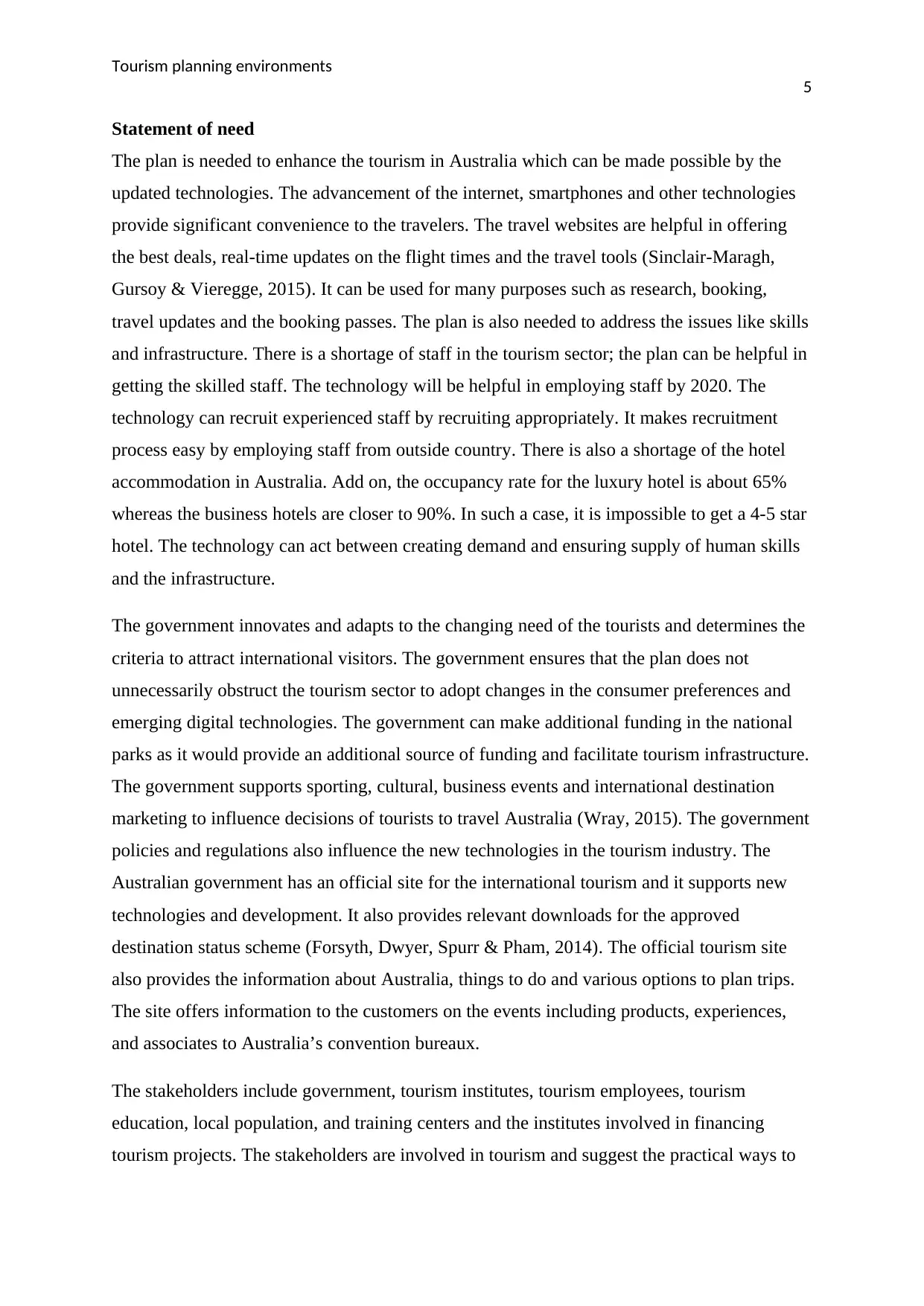
Tourism planning environments
5
Statement of need
The plan is needed to enhance the tourism in Australia which can be made possible by the
updated technologies. The advancement of the internet, smartphones and other technologies
provide significant convenience to the travelers. The travel websites are helpful in offering
the best deals, real-time updates on the flight times and the travel tools (Sinclair-Maragh,
Gursoy & Vieregge, 2015). It can be used for many purposes such as research, booking,
travel updates and the booking passes. The plan is also needed to address the issues like skills
and infrastructure. There is a shortage of staff in the tourism sector; the plan can be helpful in
getting the skilled staff. The technology will be helpful in employing staff by 2020. The
technology can recruit experienced staff by recruiting appropriately. It makes recruitment
process easy by employing staff from outside country. There is also a shortage of the hotel
accommodation in Australia. Add on, the occupancy rate for the luxury hotel is about 65%
whereas the business hotels are closer to 90%. In such a case, it is impossible to get a 4-5 star
hotel. The technology can act between creating demand and ensuring supply of human skills
and the infrastructure.
The government innovates and adapts to the changing need of the tourists and determines the
criteria to attract international visitors. The government ensures that the plan does not
unnecessarily obstruct the tourism sector to adopt changes in the consumer preferences and
emerging digital technologies. The government can make additional funding in the national
parks as it would provide an additional source of funding and facilitate tourism infrastructure.
The government supports sporting, cultural, business events and international destination
marketing to influence decisions of tourists to travel Australia (Wray, 2015). The government
policies and regulations also influence the new technologies in the tourism industry. The
Australian government has an official site for the international tourism and it supports new
technologies and development. It also provides relevant downloads for the approved
destination status scheme (Forsyth, Dwyer, Spurr & Pham, 2014). The official tourism site
also provides the information about Australia, things to do and various options to plan trips.
The site offers information to the customers on the events including products, experiences,
and associates to Australia’s convention bureaux.
The stakeholders include government, tourism institutes, tourism employees, tourism
education, local population, and training centers and the institutes involved in financing
tourism projects. The stakeholders are involved in tourism and suggest the practical ways to
5
Statement of need
The plan is needed to enhance the tourism in Australia which can be made possible by the
updated technologies. The advancement of the internet, smartphones and other technologies
provide significant convenience to the travelers. The travel websites are helpful in offering
the best deals, real-time updates on the flight times and the travel tools (Sinclair-Maragh,
Gursoy & Vieregge, 2015). It can be used for many purposes such as research, booking,
travel updates and the booking passes. The plan is also needed to address the issues like skills
and infrastructure. There is a shortage of staff in the tourism sector; the plan can be helpful in
getting the skilled staff. The technology will be helpful in employing staff by 2020. The
technology can recruit experienced staff by recruiting appropriately. It makes recruitment
process easy by employing staff from outside country. There is also a shortage of the hotel
accommodation in Australia. Add on, the occupancy rate for the luxury hotel is about 65%
whereas the business hotels are closer to 90%. In such a case, it is impossible to get a 4-5 star
hotel. The technology can act between creating demand and ensuring supply of human skills
and the infrastructure.
The government innovates and adapts to the changing need of the tourists and determines the
criteria to attract international visitors. The government ensures that the plan does not
unnecessarily obstruct the tourism sector to adopt changes in the consumer preferences and
emerging digital technologies. The government can make additional funding in the national
parks as it would provide an additional source of funding and facilitate tourism infrastructure.
The government supports sporting, cultural, business events and international destination
marketing to influence decisions of tourists to travel Australia (Wray, 2015). The government
policies and regulations also influence the new technologies in the tourism industry. The
Australian government has an official site for the international tourism and it supports new
technologies and development. It also provides relevant downloads for the approved
destination status scheme (Forsyth, Dwyer, Spurr & Pham, 2014). The official tourism site
also provides the information about Australia, things to do and various options to plan trips.
The site offers information to the customers on the events including products, experiences,
and associates to Australia’s convention bureaux.
The stakeholders include government, tourism institutes, tourism employees, tourism
education, local population, and training centers and the institutes involved in financing
tourism projects. The stakeholders are involved in tourism and suggest the practical ways to
⊘ This is a preview!⊘
Do you want full access?
Subscribe today to unlock all pages.

Trusted by 1+ million students worldwide
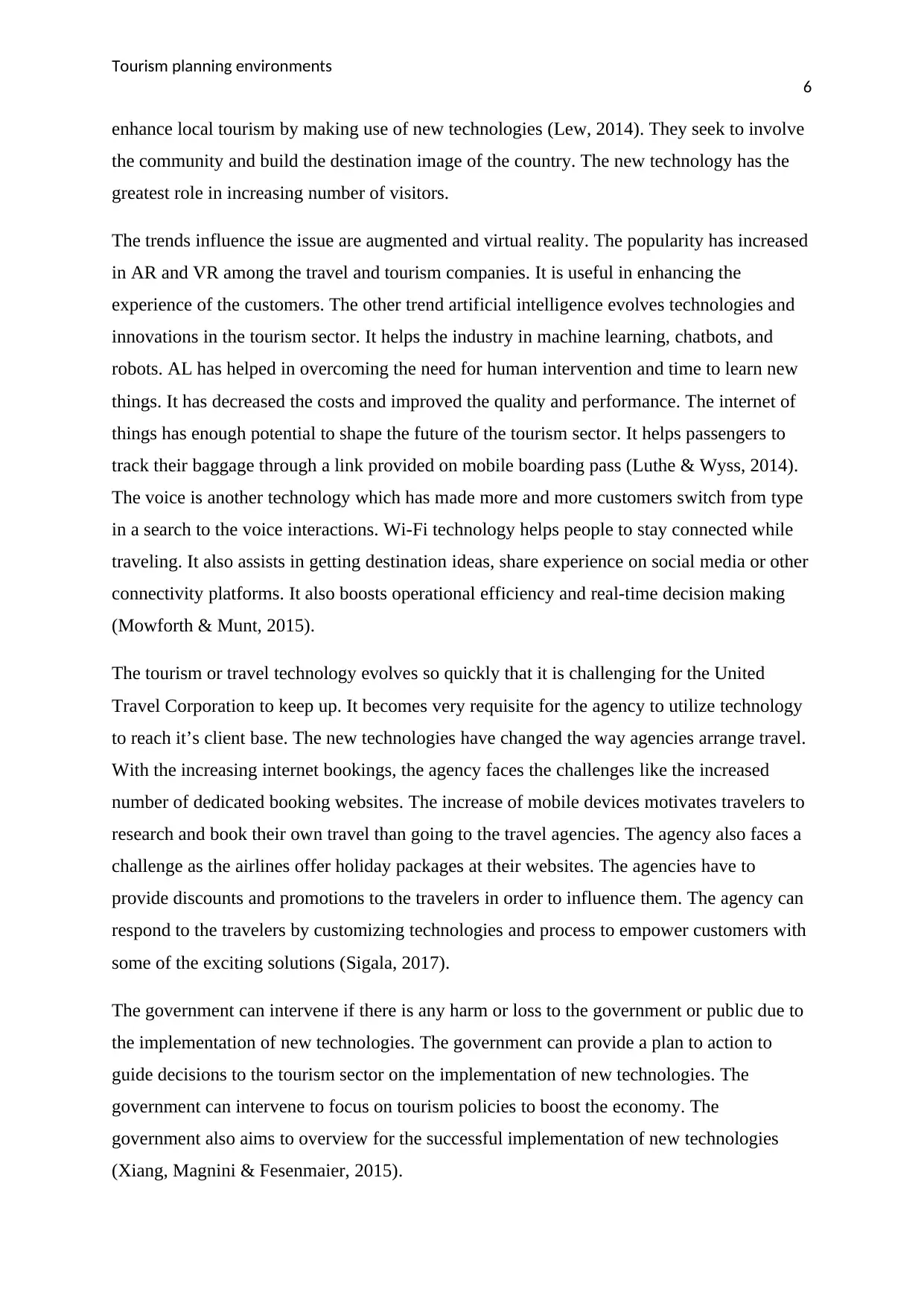
Tourism planning environments
6
enhance local tourism by making use of new technologies (Lew, 2014). They seek to involve
the community and build the destination image of the country. The new technology has the
greatest role in increasing number of visitors.
The trends influence the issue are augmented and virtual reality. The popularity has increased
in AR and VR among the travel and tourism companies. It is useful in enhancing the
experience of the customers. The other trend artificial intelligence evolves technologies and
innovations in the tourism sector. It helps the industry in machine learning, chatbots, and
robots. AL has helped in overcoming the need for human intervention and time to learn new
things. It has decreased the costs and improved the quality and performance. The internet of
things has enough potential to shape the future of the tourism sector. It helps passengers to
track their baggage through a link provided on mobile boarding pass (Luthe & Wyss, 2014).
The voice is another technology which has made more and more customers switch from type
in a search to the voice interactions. Wi-Fi technology helps people to stay connected while
traveling. It also assists in getting destination ideas, share experience on social media or other
connectivity platforms. It also boosts operational efficiency and real-time decision making
(Mowforth & Munt, 2015).
The tourism or travel technology evolves so quickly that it is challenging for the United
Travel Corporation to keep up. It becomes very requisite for the agency to utilize technology
to reach it’s client base. The new technologies have changed the way agencies arrange travel.
With the increasing internet bookings, the agency faces the challenges like the increased
number of dedicated booking websites. The increase of mobile devices motivates travelers to
research and book their own travel than going to the travel agencies. The agency also faces a
challenge as the airlines offer holiday packages at their websites. The agencies have to
provide discounts and promotions to the travelers in order to influence them. The agency can
respond to the travelers by customizing technologies and process to empower customers with
some of the exciting solutions (Sigala, 2017).
The government can intervene if there is any harm or loss to the government or public due to
the implementation of new technologies. The government can provide a plan to action to
guide decisions to the tourism sector on the implementation of new technologies. The
government can intervene to focus on tourism policies to boost the economy. The
government also aims to overview for the successful implementation of new technologies
(Xiang, Magnini & Fesenmaier, 2015).
6
enhance local tourism by making use of new technologies (Lew, 2014). They seek to involve
the community and build the destination image of the country. The new technology has the
greatest role in increasing number of visitors.
The trends influence the issue are augmented and virtual reality. The popularity has increased
in AR and VR among the travel and tourism companies. It is useful in enhancing the
experience of the customers. The other trend artificial intelligence evolves technologies and
innovations in the tourism sector. It helps the industry in machine learning, chatbots, and
robots. AL has helped in overcoming the need for human intervention and time to learn new
things. It has decreased the costs and improved the quality and performance. The internet of
things has enough potential to shape the future of the tourism sector. It helps passengers to
track their baggage through a link provided on mobile boarding pass (Luthe & Wyss, 2014).
The voice is another technology which has made more and more customers switch from type
in a search to the voice interactions. Wi-Fi technology helps people to stay connected while
traveling. It also assists in getting destination ideas, share experience on social media or other
connectivity platforms. It also boosts operational efficiency and real-time decision making
(Mowforth & Munt, 2015).
The tourism or travel technology evolves so quickly that it is challenging for the United
Travel Corporation to keep up. It becomes very requisite for the agency to utilize technology
to reach it’s client base. The new technologies have changed the way agencies arrange travel.
With the increasing internet bookings, the agency faces the challenges like the increased
number of dedicated booking websites. The increase of mobile devices motivates travelers to
research and book their own travel than going to the travel agencies. The agency also faces a
challenge as the airlines offer holiday packages at their websites. The agencies have to
provide discounts and promotions to the travelers in order to influence them. The agency can
respond to the travelers by customizing technologies and process to empower customers with
some of the exciting solutions (Sigala, 2017).
The government can intervene if there is any harm or loss to the government or public due to
the implementation of new technologies. The government can provide a plan to action to
guide decisions to the tourism sector on the implementation of new technologies. The
government can intervene to focus on tourism policies to boost the economy. The
government also aims to overview for the successful implementation of new technologies
(Xiang, Magnini & Fesenmaier, 2015).
Paraphrase This Document
Need a fresh take? Get an instant paraphrase of this document with our AI Paraphraser
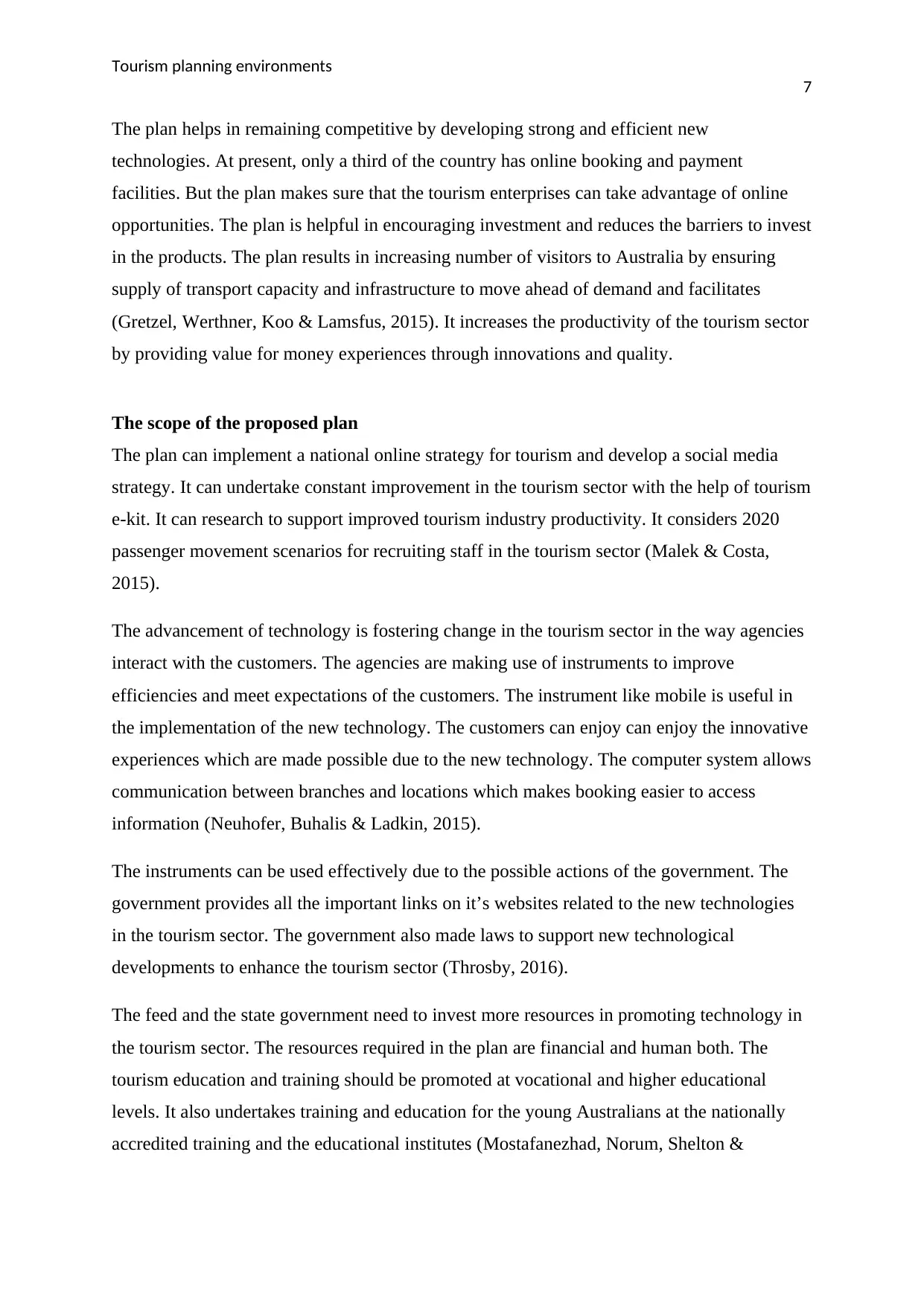
Tourism planning environments
7
The plan helps in remaining competitive by developing strong and efficient new
technologies. At present, only a third of the country has online booking and payment
facilities. But the plan makes sure that the tourism enterprises can take advantage of online
opportunities. The plan is helpful in encouraging investment and reduces the barriers to invest
in the products. The plan results in increasing number of visitors to Australia by ensuring
supply of transport capacity and infrastructure to move ahead of demand and facilitates
(Gretzel, Werthner, Koo & Lamsfus, 2015). It increases the productivity of the tourism sector
by providing value for money experiences through innovations and quality.
The scope of the proposed plan
The plan can implement a national online strategy for tourism and develop a social media
strategy. It can undertake constant improvement in the tourism sector with the help of tourism
e-kit. It can research to support improved tourism industry productivity. It considers 2020
passenger movement scenarios for recruiting staff in the tourism sector (Malek & Costa,
2015).
The advancement of technology is fostering change in the tourism sector in the way agencies
interact with the customers. The agencies are making use of instruments to improve
efficiencies and meet expectations of the customers. The instrument like mobile is useful in
the implementation of the new technology. The customers can enjoy can enjoy the innovative
experiences which are made possible due to the new technology. The computer system allows
communication between branches and locations which makes booking easier to access
information (Neuhofer, Buhalis & Ladkin, 2015).
The instruments can be used effectively due to the possible actions of the government. The
government provides all the important links on it’s websites related to the new technologies
in the tourism sector. The government also made laws to support new technological
developments to enhance the tourism sector (Throsby, 2016).
The feed and the state government need to invest more resources in promoting technology in
the tourism sector. The resources required in the plan are financial and human both. The
tourism education and training should be promoted at vocational and higher educational
levels. It also undertakes training and education for the young Australians at the nationally
accredited training and the educational institutes (Mostafanezhad, Norum, Shelton &
7
The plan helps in remaining competitive by developing strong and efficient new
technologies. At present, only a third of the country has online booking and payment
facilities. But the plan makes sure that the tourism enterprises can take advantage of online
opportunities. The plan is helpful in encouraging investment and reduces the barriers to invest
in the products. The plan results in increasing number of visitors to Australia by ensuring
supply of transport capacity and infrastructure to move ahead of demand and facilitates
(Gretzel, Werthner, Koo & Lamsfus, 2015). It increases the productivity of the tourism sector
by providing value for money experiences through innovations and quality.
The scope of the proposed plan
The plan can implement a national online strategy for tourism and develop a social media
strategy. It can undertake constant improvement in the tourism sector with the help of tourism
e-kit. It can research to support improved tourism industry productivity. It considers 2020
passenger movement scenarios for recruiting staff in the tourism sector (Malek & Costa,
2015).
The advancement of technology is fostering change in the tourism sector in the way agencies
interact with the customers. The agencies are making use of instruments to improve
efficiencies and meet expectations of the customers. The instrument like mobile is useful in
the implementation of the new technology. The customers can enjoy can enjoy the innovative
experiences which are made possible due to the new technology. The computer system allows
communication between branches and locations which makes booking easier to access
information (Neuhofer, Buhalis & Ladkin, 2015).
The instruments can be used effectively due to the possible actions of the government. The
government provides all the important links on it’s websites related to the new technologies
in the tourism sector. The government also made laws to support new technological
developments to enhance the tourism sector (Throsby, 2016).
The feed and the state government need to invest more resources in promoting technology in
the tourism sector. The resources required in the plan are financial and human both. The
tourism education and training should be promoted at vocational and higher educational
levels. It also undertakes training and education for the young Australians at the nationally
accredited training and the educational institutes (Mostafanezhad, Norum, Shelton &
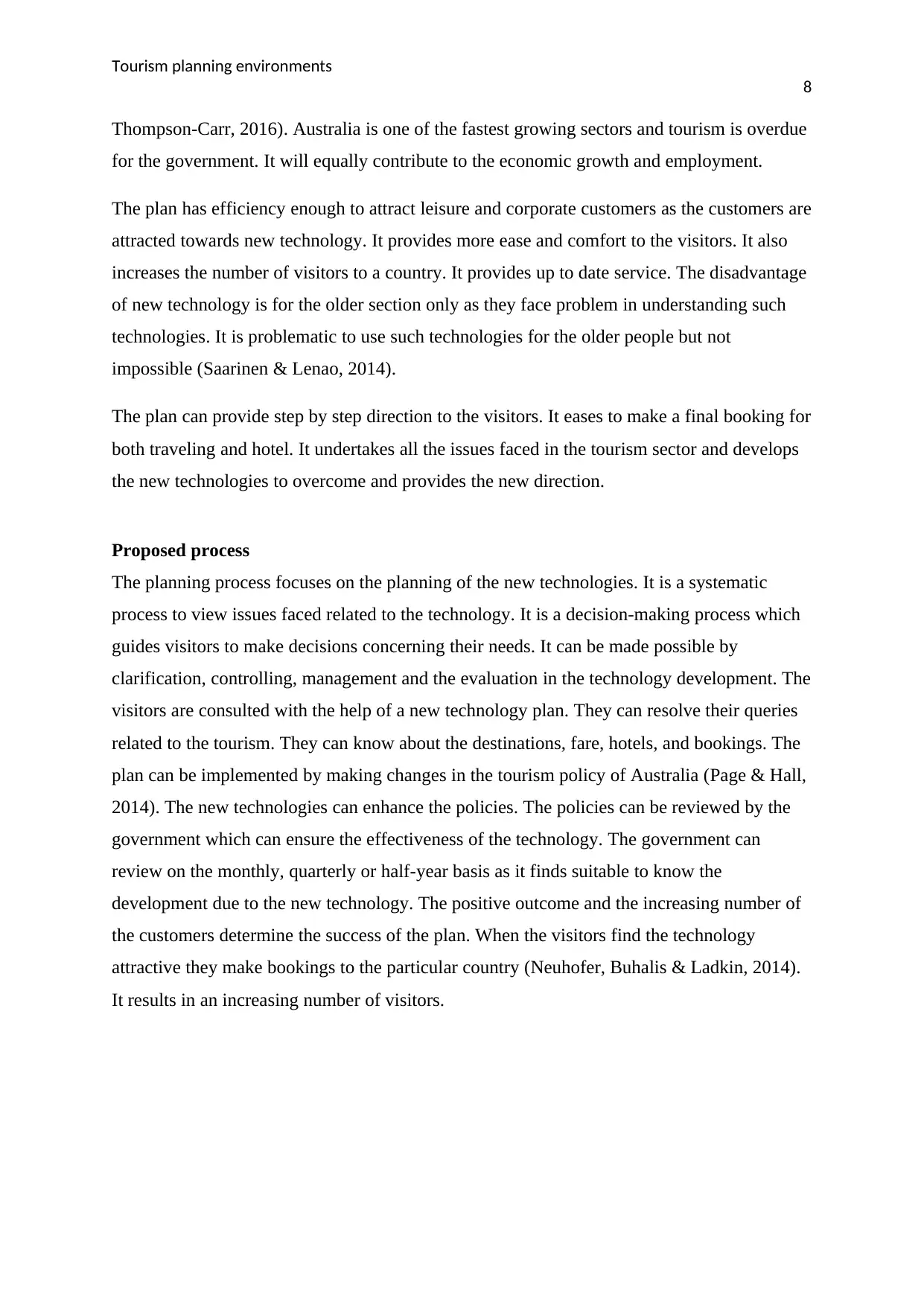
Tourism planning environments
8
Thompson-Carr, 2016). Australia is one of the fastest growing sectors and tourism is overdue
for the government. It will equally contribute to the economic growth and employment.
The plan has efficiency enough to attract leisure and corporate customers as the customers are
attracted towards new technology. It provides more ease and comfort to the visitors. It also
increases the number of visitors to a country. It provides up to date service. The disadvantage
of new technology is for the older section only as they face problem in understanding such
technologies. It is problematic to use such technologies for the older people but not
impossible (Saarinen & Lenao, 2014).
The plan can provide step by step direction to the visitors. It eases to make a final booking for
both traveling and hotel. It undertakes all the issues faced in the tourism sector and develops
the new technologies to overcome and provides the new direction.
Proposed process
The planning process focuses on the planning of the new technologies. It is a systematic
process to view issues faced related to the technology. It is a decision-making process which
guides visitors to make decisions concerning their needs. It can be made possible by
clarification, controlling, management and the evaluation in the technology development. The
visitors are consulted with the help of a new technology plan. They can resolve their queries
related to the tourism. They can know about the destinations, fare, hotels, and bookings. The
plan can be implemented by making changes in the tourism policy of Australia (Page & Hall,
2014). The new technologies can enhance the policies. The policies can be reviewed by the
government which can ensure the effectiveness of the technology. The government can
review on the monthly, quarterly or half-year basis as it finds suitable to know the
development due to the new technology. The positive outcome and the increasing number of
the customers determine the success of the plan. When the visitors find the technology
attractive they make bookings to the particular country (Neuhofer, Buhalis & Ladkin, 2014).
It results in an increasing number of visitors.
8
Thompson-Carr, 2016). Australia is one of the fastest growing sectors and tourism is overdue
for the government. It will equally contribute to the economic growth and employment.
The plan has efficiency enough to attract leisure and corporate customers as the customers are
attracted towards new technology. It provides more ease and comfort to the visitors. It also
increases the number of visitors to a country. It provides up to date service. The disadvantage
of new technology is for the older section only as they face problem in understanding such
technologies. It is problematic to use such technologies for the older people but not
impossible (Saarinen & Lenao, 2014).
The plan can provide step by step direction to the visitors. It eases to make a final booking for
both traveling and hotel. It undertakes all the issues faced in the tourism sector and develops
the new technologies to overcome and provides the new direction.
Proposed process
The planning process focuses on the planning of the new technologies. It is a systematic
process to view issues faced related to the technology. It is a decision-making process which
guides visitors to make decisions concerning their needs. It can be made possible by
clarification, controlling, management and the evaluation in the technology development. The
visitors are consulted with the help of a new technology plan. They can resolve their queries
related to the tourism. They can know about the destinations, fare, hotels, and bookings. The
plan can be implemented by making changes in the tourism policy of Australia (Page & Hall,
2014). The new technologies can enhance the policies. The policies can be reviewed by the
government which can ensure the effectiveness of the technology. The government can
review on the monthly, quarterly or half-year basis as it finds suitable to know the
development due to the new technology. The positive outcome and the increasing number of
the customers determine the success of the plan. When the visitors find the technology
attractive they make bookings to the particular country (Neuhofer, Buhalis & Ladkin, 2014).
It results in an increasing number of visitors.
⊘ This is a preview!⊘
Do you want full access?
Subscribe today to unlock all pages.

Trusted by 1+ million students worldwide
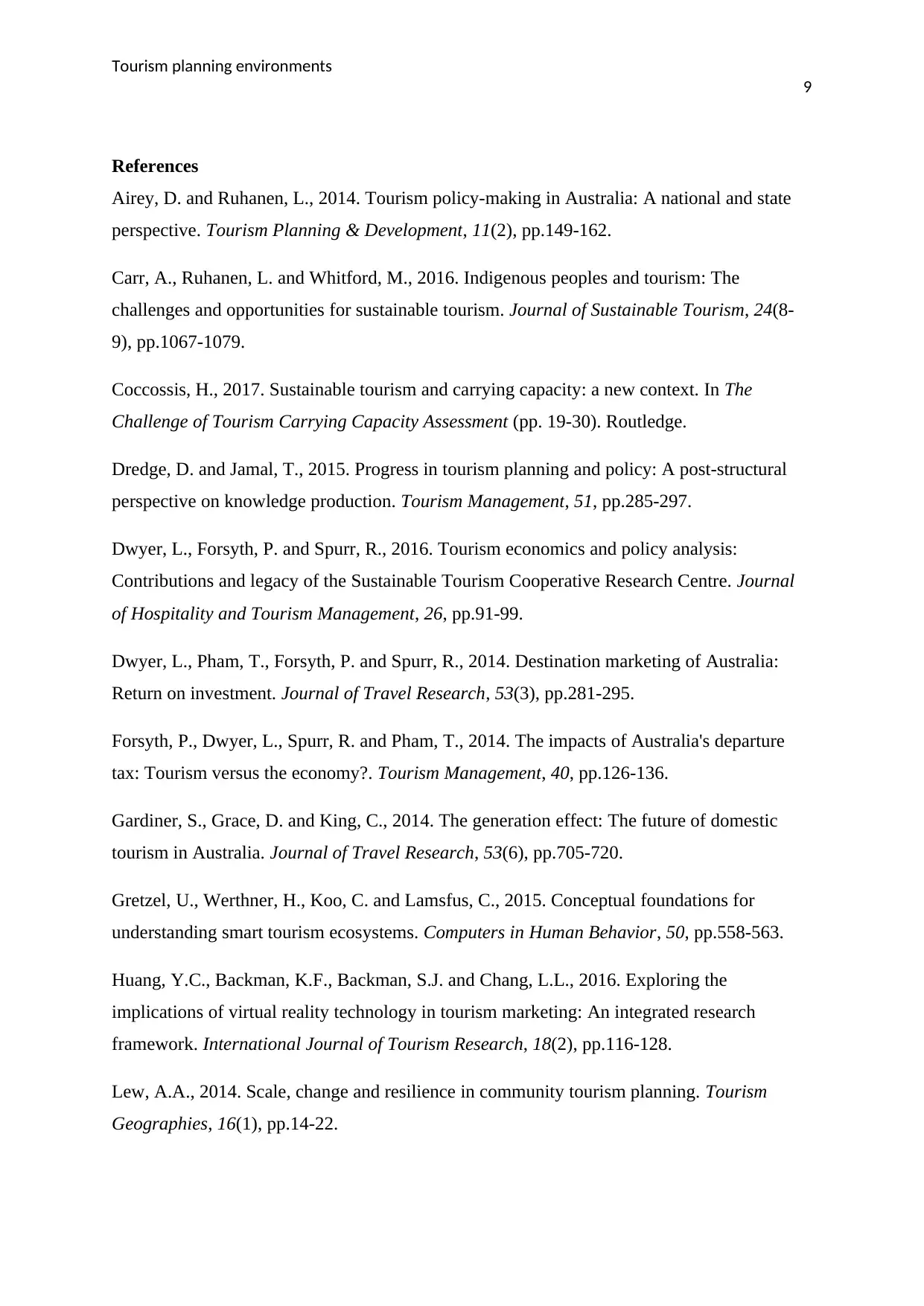
Tourism planning environments
9
References
Airey, D. and Ruhanen, L., 2014. Tourism policy-making in Australia: A national and state
perspective. Tourism Planning & Development, 11(2), pp.149-162.
Carr, A., Ruhanen, L. and Whitford, M., 2016. Indigenous peoples and tourism: The
challenges and opportunities for sustainable tourism. Journal of Sustainable Tourism, 24(8-
9), pp.1067-1079.
Coccossis, H., 2017. Sustainable tourism and carrying capacity: a new context. In The
Challenge of Tourism Carrying Capacity Assessment (pp. 19-30). Routledge.
Dredge, D. and Jamal, T., 2015. Progress in tourism planning and policy: A post-structural
perspective on knowledge production. Tourism Management, 51, pp.285-297.
Dwyer, L., Forsyth, P. and Spurr, R., 2016. Tourism economics and policy analysis:
Contributions and legacy of the Sustainable Tourism Cooperative Research Centre. Journal
of Hospitality and Tourism Management, 26, pp.91-99.
Dwyer, L., Pham, T., Forsyth, P. and Spurr, R., 2014. Destination marketing of Australia:
Return on investment. Journal of Travel Research, 53(3), pp.281-295.
Forsyth, P., Dwyer, L., Spurr, R. and Pham, T., 2014. The impacts of Australia's departure
tax: Tourism versus the economy?. Tourism Management, 40, pp.126-136.
Gardiner, S., Grace, D. and King, C., 2014. The generation effect: The future of domestic
tourism in Australia. Journal of Travel Research, 53(6), pp.705-720.
Gretzel, U., Werthner, H., Koo, C. and Lamsfus, C., 2015. Conceptual foundations for
understanding smart tourism ecosystems. Computers in Human Behavior, 50, pp.558-563.
Huang, Y.C., Backman, K.F., Backman, S.J. and Chang, L.L., 2016. Exploring the
implications of virtual reality technology in tourism marketing: An integrated research
framework. International Journal of Tourism Research, 18(2), pp.116-128.
Lew, A.A., 2014. Scale, change and resilience in community tourism planning. Tourism
Geographies, 16(1), pp.14-22.
9
References
Airey, D. and Ruhanen, L., 2014. Tourism policy-making in Australia: A national and state
perspective. Tourism Planning & Development, 11(2), pp.149-162.
Carr, A., Ruhanen, L. and Whitford, M., 2016. Indigenous peoples and tourism: The
challenges and opportunities for sustainable tourism. Journal of Sustainable Tourism, 24(8-
9), pp.1067-1079.
Coccossis, H., 2017. Sustainable tourism and carrying capacity: a new context. In The
Challenge of Tourism Carrying Capacity Assessment (pp. 19-30). Routledge.
Dredge, D. and Jamal, T., 2015. Progress in tourism planning and policy: A post-structural
perspective on knowledge production. Tourism Management, 51, pp.285-297.
Dwyer, L., Forsyth, P. and Spurr, R., 2016. Tourism economics and policy analysis:
Contributions and legacy of the Sustainable Tourism Cooperative Research Centre. Journal
of Hospitality and Tourism Management, 26, pp.91-99.
Dwyer, L., Pham, T., Forsyth, P. and Spurr, R., 2014. Destination marketing of Australia:
Return on investment. Journal of Travel Research, 53(3), pp.281-295.
Forsyth, P., Dwyer, L., Spurr, R. and Pham, T., 2014. The impacts of Australia's departure
tax: Tourism versus the economy?. Tourism Management, 40, pp.126-136.
Gardiner, S., Grace, D. and King, C., 2014. The generation effect: The future of domestic
tourism in Australia. Journal of Travel Research, 53(6), pp.705-720.
Gretzel, U., Werthner, H., Koo, C. and Lamsfus, C., 2015. Conceptual foundations for
understanding smart tourism ecosystems. Computers in Human Behavior, 50, pp.558-563.
Huang, Y.C., Backman, K.F., Backman, S.J. and Chang, L.L., 2016. Exploring the
implications of virtual reality technology in tourism marketing: An integrated research
framework. International Journal of Tourism Research, 18(2), pp.116-128.
Lew, A.A., 2014. Scale, change and resilience in community tourism planning. Tourism
Geographies, 16(1), pp.14-22.
Paraphrase This Document
Need a fresh take? Get an instant paraphrase of this document with our AI Paraphraser
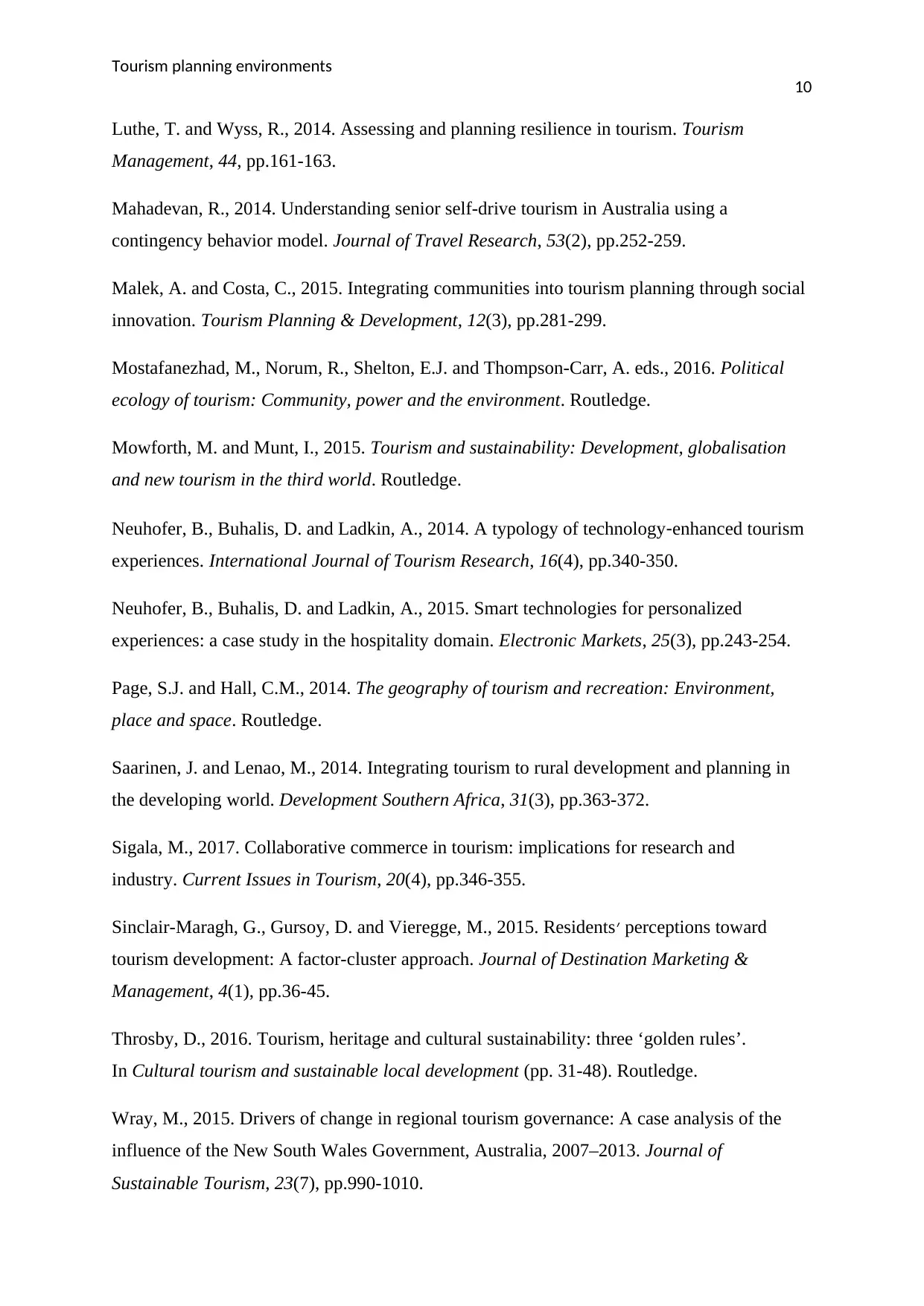
Tourism planning environments
10
Luthe, T. and Wyss, R., 2014. Assessing and planning resilience in tourism. Tourism
Management, 44, pp.161-163.
Mahadevan, R., 2014. Understanding senior self-drive tourism in Australia using a
contingency behavior model. Journal of Travel Research, 53(2), pp.252-259.
Malek, A. and Costa, C., 2015. Integrating communities into tourism planning through social
innovation. Tourism Planning & Development, 12(3), pp.281-299.
Mostafanezhad, M., Norum, R., Shelton, E.J. and Thompson-Carr, A. eds., 2016. Political
ecology of tourism: Community, power and the environment. Routledge.
Mowforth, M. and Munt, I., 2015. Tourism and sustainability: Development, globalisation
and new tourism in the third world. Routledge.
Neuhofer, B., Buhalis, D. and Ladkin, A., 2014. A typology of technology‐enhanced tourism
experiences. International Journal of Tourism Research, 16(4), pp.340-350.
Neuhofer, B., Buhalis, D. and Ladkin, A., 2015. Smart technologies for personalized
experiences: a case study in the hospitality domain. Electronic Markets, 25(3), pp.243-254.
Page, S.J. and Hall, C.M., 2014. The geography of tourism and recreation: Environment,
place and space. Routledge.
Saarinen, J. and Lenao, M., 2014. Integrating tourism to rural development and planning in
the developing world. Development Southern Africa, 31(3), pp.363-372.
Sigala, M., 2017. Collaborative commerce in tourism: implications for research and
industry. Current Issues in Tourism, 20(4), pp.346-355.
Sinclair-Maragh, G., Gursoy, D. and Vieregge, M., 2015. Residents׳ perceptions toward
tourism development: A factor-cluster approach. Journal of Destination Marketing &
Management, 4(1), pp.36-45.
Throsby, D., 2016. Tourism, heritage and cultural sustainability: three ‘golden rules’.
In Cultural tourism and sustainable local development (pp. 31-48). Routledge.
Wray, M., 2015. Drivers of change in regional tourism governance: A case analysis of the
influence of the New South Wales Government, Australia, 2007–2013. Journal of
Sustainable Tourism, 23(7), pp.990-1010.
10
Luthe, T. and Wyss, R., 2014. Assessing and planning resilience in tourism. Tourism
Management, 44, pp.161-163.
Mahadevan, R., 2014. Understanding senior self-drive tourism in Australia using a
contingency behavior model. Journal of Travel Research, 53(2), pp.252-259.
Malek, A. and Costa, C., 2015. Integrating communities into tourism planning through social
innovation. Tourism Planning & Development, 12(3), pp.281-299.
Mostafanezhad, M., Norum, R., Shelton, E.J. and Thompson-Carr, A. eds., 2016. Political
ecology of tourism: Community, power and the environment. Routledge.
Mowforth, M. and Munt, I., 2015. Tourism and sustainability: Development, globalisation
and new tourism in the third world. Routledge.
Neuhofer, B., Buhalis, D. and Ladkin, A., 2014. A typology of technology‐enhanced tourism
experiences. International Journal of Tourism Research, 16(4), pp.340-350.
Neuhofer, B., Buhalis, D. and Ladkin, A., 2015. Smart technologies for personalized
experiences: a case study in the hospitality domain. Electronic Markets, 25(3), pp.243-254.
Page, S.J. and Hall, C.M., 2014. The geography of tourism and recreation: Environment,
place and space. Routledge.
Saarinen, J. and Lenao, M., 2014. Integrating tourism to rural development and planning in
the developing world. Development Southern Africa, 31(3), pp.363-372.
Sigala, M., 2017. Collaborative commerce in tourism: implications for research and
industry. Current Issues in Tourism, 20(4), pp.346-355.
Sinclair-Maragh, G., Gursoy, D. and Vieregge, M., 2015. Residents׳ perceptions toward
tourism development: A factor-cluster approach. Journal of Destination Marketing &
Management, 4(1), pp.36-45.
Throsby, D., 2016. Tourism, heritage and cultural sustainability: three ‘golden rules’.
In Cultural tourism and sustainable local development (pp. 31-48). Routledge.
Wray, M., 2015. Drivers of change in regional tourism governance: A case analysis of the
influence of the New South Wales Government, Australia, 2007–2013. Journal of
Sustainable Tourism, 23(7), pp.990-1010.
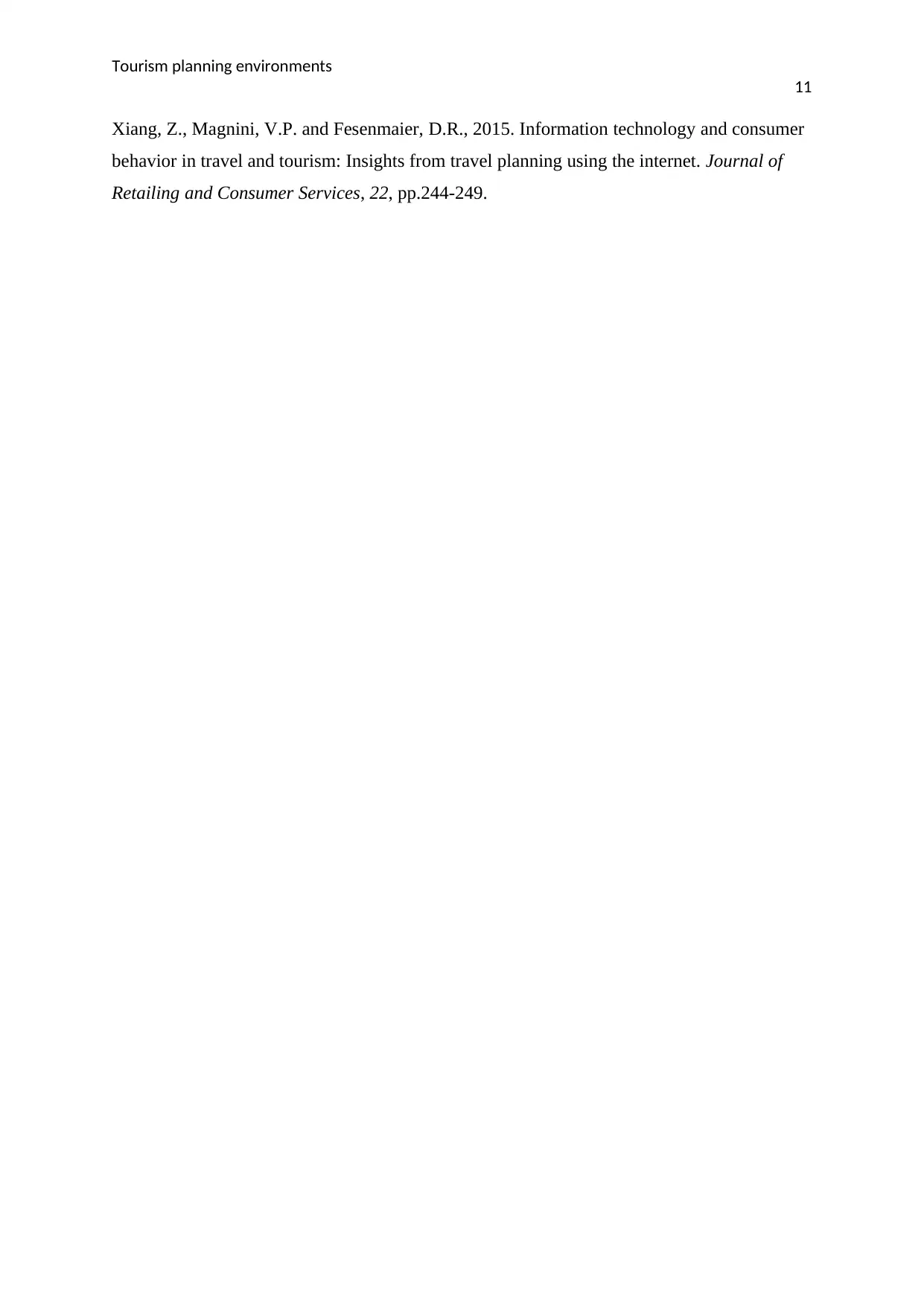
Tourism planning environments
11
Xiang, Z., Magnini, V.P. and Fesenmaier, D.R., 2015. Information technology and consumer
behavior in travel and tourism: Insights from travel planning using the internet. Journal of
Retailing and Consumer Services, 22, pp.244-249.
11
Xiang, Z., Magnini, V.P. and Fesenmaier, D.R., 2015. Information technology and consumer
behavior in travel and tourism: Insights from travel planning using the internet. Journal of
Retailing and Consumer Services, 22, pp.244-249.
⊘ This is a preview!⊘
Do you want full access?
Subscribe today to unlock all pages.

Trusted by 1+ million students worldwide
1 out of 12
Related Documents
Your All-in-One AI-Powered Toolkit for Academic Success.
+13062052269
info@desklib.com
Available 24*7 on WhatsApp / Email
![[object Object]](/_next/static/media/star-bottom.7253800d.svg)
Unlock your academic potential
Copyright © 2020–2025 A2Z Services. All Rights Reserved. Developed and managed by ZUCOL.





